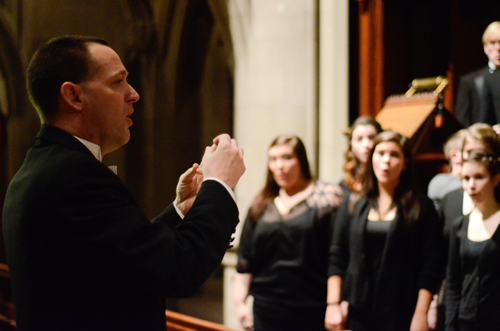by Daniel Hathaway

Whether or not he wrote the work as a kind of musical resumé to gain a more lucrative position, Bach’s intentions were obviously to have the Mass performed, not venerated as one of the great products of Western civilization. It’s only through performance that the piece comes to life — or not. Stodgy, pious interpretations do little to enhance its reputation, but a vibrant, involved reading of the quality we heard on Saturday evening, April 18 in Gamble Auditorium guarantees its future relevance and longevity.
Conducting bare-handed, Garner set brisk tempos from the beginning and called for light, transparent textures. The 70-voice Baldwin Wallace Festival Choir sang with deep commitment and an animation that extended beyond their clear, blended voices: they bobbed and weaved to the music, even when they weren’t singing, and resembled nothing so much as six dozen baroque head-bangers having the time of their lives negotiating Bach’s tricky counterpoint. They also sounded terrific.
Garner took care to thin down the orchestration here and there, both for lightness and textural contrast. Sometimes only the first stands of strings played. Sometimes the double basses dropped out. He had flutist Sean Gabriel deliver his aria obbligatos from the front of the stage, where his wooden flute could project clearly into the house. And he alternated the keyboard continuo duties between organist Nicole Keller and harpsichordist Jason Aquila.
Though not for musical effect, Garner seated the four soloists at the sides of the stage. They came front and center only when they sang, avoiding the usual situation where audience and soloists spend the duration of the piece staring at each other.
Soprano Jessica Petrus and countertenor Eric Jurenas sang beautifully on their own, but Petrus’s bright, alluring voice and Jurenas’s focused tone, even in his lower range, also blended handsomely in their duets. Tenor John Russell and baritone Paul Max Tipton were fine choices to complete the quartet of soloists (who never all sing together). Russell and Petrus made a lovely pairing for the buoyant duet in the “Domine Deus” of the “Gloria.” Tipton blended wonderfully with hornist Ken Wadenpful and bassoonists George Sakakeeny and Hannah Previty in the striking “Quoniam” movement. Though Garner’s quick tempo left Tipton a little breathless in the “Et in Spiritum Sanctum” movement of the “Symbolum Nicenum,” the whole aria was effervescent.
Garner’s sure pacing of the Mass kept the piece moving, but allowed for some gorgeous episodes when forward motion was abandoned to savor the moment. That happened in the “Qui tollis” of the “Gloria,” when the chorus sang pianissimo and seated, again in the “Et incarnatus est” of the “Symbolum,” and, most effectively, in the “Crucifixus” that followed. Bach borrowed its music from his early cantata, Weinen, Klagen, Sorgen, Zagen, but added a stunning, sudden modulation at the end to connect with the “Et resurrexit.” Garner took the “Crucifixus” at a dead-slow tempo, shaping expressive swells and ebbs, and let the piece end in total calm before all heaven broke loose.
Expert instrumental obbligatos were provided by concertmaster Julian Ross and oboe d’amore player Danna Sundet. The piccolo trumpet section — David Duro, Isaac Hopkins and Julissa Shinsky — was simply flawless. Timpanist Josh Ryan, who otherwise sat out a lot on Saturday night, crowned climaxes with festive punctuation.
Perhaps there might have been more of a sense of connection between the “Benedictus” and the “Agnus Dei” that brings the Mass to an end. But the highest praise this listener can give Saturday’s performance is that he sat through more than two hours of a complicated Bach work without ever worrying that something just around the corner might go awry. To the contrary, the performance was genuinely enjoyable from “Kyrie” to “Dona nobis pacem”. Midway through, at the end of the stirring “Et resurrexit,” he scribbled across his program, “YEAH!”
Published on ClevelandClassical.com April 21, 2015.
Click here for a printable copy of this article




